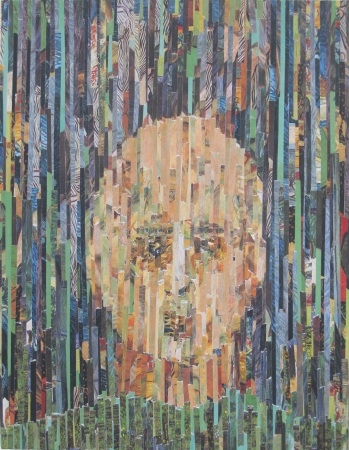Peckl has been employing this method of collage technique for six years. Previous work was based on palindromes of words realised with coloured stamps on wood. The new works featuring within the show seem to be generated in a state of ecstasy, while the artist’s expression follows closely the style of his models. Peckl used to select atlases of stars and topography for his pictures of landscapes and atmospheric ray- sites. Now he takes possession of monographic books of the contemporary and the historical as well as of scientific books of the human anatomy or of fauna. In the face of its mass medial disposability, the artist cuts and shredders it disrespectfully into the finest strips. Peckl exploits the thus gained strips to create his own palette and “gesture” for a representation of heads and figures with or without attributes which are oriented towards the traditional genre of the portrait. The titles of the pictures refer to prominent contemporary and old masters of art whose masterpiece- reproductions in catalogues analogously serve as the artist’s source of material. On the other hand, the persons themselves represented in the pictures do not illustrate any bodily resemblance to their models; rather, it could be said, of an ideal- typical character.
Peckl creates a distance between the picture and its recipient through formal strategies like parallel running stripes which draw the viewer’s attention to the coloration and the rhythm of the composition as the characteristics of each portrait. For example, the grey brown flesh tones of one “painting” contrast with a clear blue sky composed in strung- out strips while carrying the title “Leni Riefenstah”; another picture is animated by staccato- like sequences of light reflections to define a colourisation which leads to the title “Tizian”.
It is an individual dynamic proceeding from Manfred Peckl’s collages to generate its special kind of attraction and fascination. The artist arranges his material of stripes in various compositions on the picture, as for example in synchronical orders, spinning circles or radial- axial explosions of rays. These multiple changes of direction affect the common continuum of (picture) space to suggest an extended perception of the exponentiated dimensions of light, time and motion. At the sight of the artist’s collages, it seems possible to experience the history of art and the human being in accordance with quick motion. The past, the present and the future collapses into one and we are seized with the visionary idea of an all surveying knowledge. According to the phenomenological philosopher Bernhard Waldenfels, there is always something “foreign” appearing at the threshold of our senses and experiences. It plays the role of the extraordinary in the fashion of interferences and divergences along the borders of the order and it trespasses borders without nullifying them.
